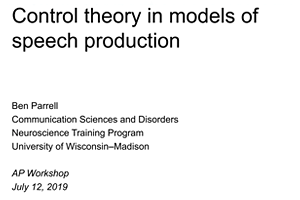Legacy: Asilomar Workshop: 2019
Presentations: ARP_AP
Advancing Research in Phonology via Articulatory Phonology (ARP_AP)
12-14 July, 2019, Asilomar Conference Center, Pacific Grove, CA
Advancing Research in Phonology via Articulatory Phonology (ARP_AP) was a workshop that gathered experts in Articulatory Phonology (AP) and other theoretical approaches to explore the topics that are especially appropriate for further developing the AP framework and its relations to other contemporary phonological theorizing. Because AP generates data that has, in many cases, never been examined before, there are challenges to comparing the success of AP relative to other phonologies. Nonetheless, the kinds of data generated by research based on AP principles have now come to be more typical of discussions in phonological debates at large. The confluence of the major changes in mainstream phonological theory and the lack of a synthesis of the existing AP literature made 2019 an ideal time for focusing on AP and the phonological questions it can address.
The workshop was held 12-14 July 2019 at the Asilomar Conference Center, Pacific Grove, CA. Attendees heard stage-setting talks, followed by intensive discussions in one of three working groups on three major themes: Representation of prosody in AP; Role of the lexicon in AP; and Redefinition of the tasks in the task-dynamic model of AP. The main goal of providing perspectives on current features of Articulatory Phonology and specific proposals for changes to the model were discussed and summarized in the final group discussion.
There were 35 participants, including 10 students and recent Ph.D. awardees funded by the grant that funded this workshop. Present were three of the original key researchers responsible for the initial development of the Haskins Gestural Model: Louis Goldstein, Philip Rubin, and Elliot Saltzman. Cathe Browman, the co-developer of articulatory phonology, died in 2008 and was honored at this meeting. Other participants included Dani Byrd, Adamantios Gafos, Khalil Iskarous, Jelena Krivokapic, Ben Parrell, and Douglas Whalen.
Several of the talks were recorded, and are available for viewing. The slides for those talks and others are also available.Throughout its history, Haskins Laboratories has been dedicated to fundamental research and innovation, from developing the first interactive software replicating the interplay of the tongue, lips and palate in human speech to using functional Magnetic Resonance Imaging (fMRI) to study blood flow in the brain as a child reads. These objective research approaches, which Haskins scientists have pursued wherever they lead, have given the work of the Haskins Laboratories special credibility at times when controversy surrounded many issues concerning language and reading.





